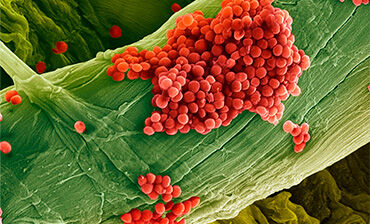Invasive pneumococcal disease

Pneumococcal diseases are symptomatic infections caused by the bacterium Streptococcus pneumoniae (S. pneumoniae), commonly referred to as pneumococci. Usually the invasive pneumococcal disease (IPD) term is used for more severe and invasive pneumococcal infections. There is not an exact time frame for symptoms to appear after exposure, but it is typically estimated to be between 1 to 3 days.
Key facts
Common symptoms are:
- Infection of the middle ear (otitis media)
- sinus infection
- pink eye (conjunctivitis)
- pneumonia
Other, less frequent infections caused by S. pneumoniae include:
- infection or inflammation in the area around the eyes
- bone disorders
- infection or inflammation of the inner lining of the heart chambers and valves
- inflammation of the thin sac surrounding the heart
- inflammation or infection of the lining of the abdominal cavity
- infection within a joint (pyogenic arthritis)
- soft tissue infections
- bloodstream infection, which can lead to various symptoms and health complications in newborns (neonatal septicaemia)
In the case of more invasive pneumococcal infections, symptoms include:
- bacteremia (bloodstream infection),
- sepsis (a serious infection that affects the entire body through the blood)
- meningitis (an infection that can affect the brain and spinal cord)
- osteomyelitis (an infection that can affect the bones)
Risk for people
Pneumococcal infections can affect individuals of all ages, but those at higher risk include children younger than two years of age and adults aged 65 years and older.
How it spreads
The bacteria that cause pneumococcal disease often live in a person’s nose and throat without causing any disease. However, if the bacteria move to another part of the body, the resulting infection can be very serious
This type of bacteria can be transmitted from one person to another through respiratory droplets when they cough, sneeze, or talk. The exact duration of contagiousness for individuals with an S. pneumoniae infection is unknown. Individuals may remain contagious until their oral and nasal secretions no longer contain a significant number of pneumococci.
Vaccination and treatment
There are two main types of pneumococcal vaccines: pneumococcal polysaccharide vaccine (PPV) and pneumococcal conjugate vaccine (PCV).
PPV is not very effective in stimulating an immune response in children under two and doesn't reduce the presence of pneumococcal bacteria. On the other hand, PCV is effective for infants, helps build immune memory, and reduces the occurrence of pneumococcal bacteria.
Currently, most European vaccination programs prefer using PCV as their primary pneumococcal vaccine.
Protective measures
Vaccinating children against S. pneumoniae is one of the most effective public health measures for preventing invasive pneumococcal disease (IPD). It not only protects the children who receive it (direct effect) but also helps safeguard unvaccinated populations (indirect effect).







